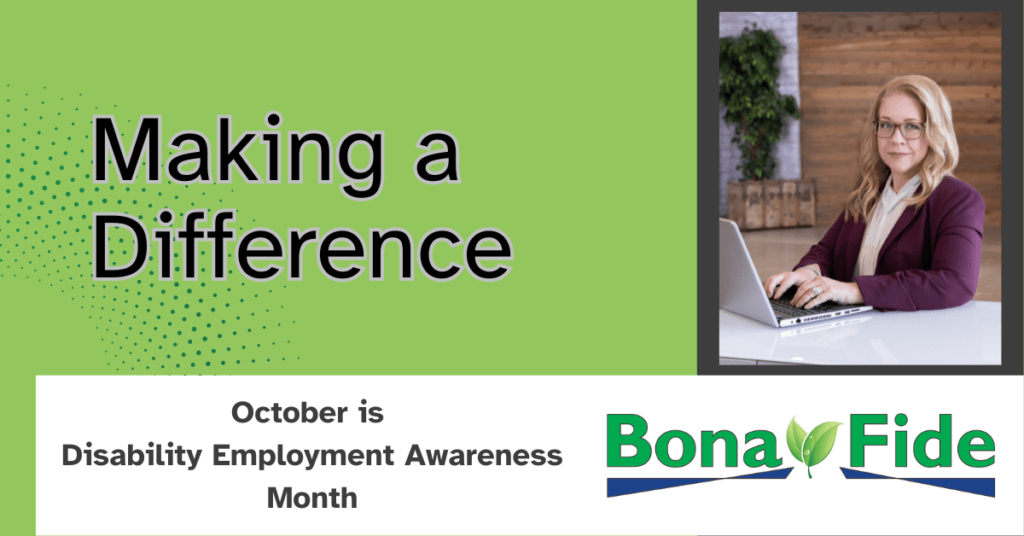Disability Employment Awareness Month: Supporting People with Disabilities
Every October, we observe Disability Employment Awareness Month, taking time to acknowledge the contributions made by individuals with disabilities to our workplaces. These contributions tell a bigger story about inclusion and the societal change that’s still needed
Disability is not an obstacle to success – it is a natural part of the human experience. By supporting career advancement for people with disabilities, we can help them overcome challenges and achieve their dreams.
Doing her part to support this change is Tina Tyko, a long-time advocate for those with disabilities. In her roles as an employment specialist, a job developer, and currently a project manager at Bona Fide, Tina spearheads programs aimed at integrating people with severe disabilities into conventional work environments.
Tina’s experiences can teach us a lot about how to support people with disabilities in the workplace. Let’s consider a few examples.
Supporting Trauma and Memory Loss with Patience
Over the years, Tina’s work has presented challenges that underlined the need for patience, adaptation, and communication. One employee that was recovering from a TBI (traumatic brain injury) had serious short-term memory loss.
“It took over a year just to get him to remember he even had a job,” she relates, “we had to make accommodations for him by having GSA (General Services Administration) approve signage to be placed around the facility to help remind him of where he was and how to get to the next location. It seems like a simple task for you and I, but someone with a TBI can get easily confused just walking down a hallway.”
Helpful signage was a small but innovative accommodation that supported this gentleman while he recovered. He continued to recuperate from his injuries and he returned to an independent life. Are there ways to show such thoughtful accommodations in your workplace? Is there any benefit to putting forth the effort?
Inclusion’s Impact on Business and Society

Tina cites examples of how businesses that had reservations about hiring individuals with developmental disabilities witnessed multiple benefits once they embraced inclusion.
A high-end fitness center she collaborated with reported a growth in their customer base and improvement in their survey results after hiring a candidate with a developmental disability.
Customers who saw the center’s humanitarian stance were more inclined to promote its services. The employee became the most popular member of the gym’s staff among the customers.
Tina gives another example of a restaurant, where the owner went out of his way to make the new member of their staff feel valued and integrated. “The owner made it very clear that he was an integral part of the Team. The owner set the example by always stopping what he was doing to greet him when he arrived, welcoming him into the new day.”
“The rest of the staff followed suit, and it soon became a daily ritual that even the regular customers would join in on the greeting.”
Defining Reasonable Accommodations and Best Practices
The stories Tina shares highlight the value of making reasonable accommodations and the positive outcomes they can have for company culture and community involvement. But what’s reasonable? Could employees get carried away in their expectations from their employers? Tina defines reasonable accommodations as adjustments that “do not create undue hardship or harm.” In the previous examples, it was mostly small and thoughtful changes that fostered an accommodating workplace environment.
Of course, there may be times when wheelchair access is needed, or fluorescent lighting could be causing someone difficulties for someone prone to migraines. But taking the small steps is fundamental to discovering the positive outcomes of contributing to disability inclusion.
Taking on the Challenge

But how far can inclusivity in the workplace really go? Far more than the disabilities themselves, the major barrier to wider inclusion is pessimism.
For example, could someone with vision impairment do janitorial work? How could they ascertain when something was clean? What would be the limits of their responsibilities? It’s a fair question.
And while that type of task seems daunting, Tina is optimistic even in those difficult scenarios. She believes “with the right person and appropriate accommodations, it could be successful.”
Disability is not an obstacle to success – it is a natural part of the human experience. By supporting career advancement for people with disabilities, we can help them overcome challenges and achieve their dreams.
Battling Misunderstandings and Stereotypes
Tina believes that education and communication are powerful keys in grounding acceptance for individuals with disabilities in the workspace. Tina wishes she had gotten the same advice at the beginning of her career: that patience, constant education, creativity, empathy regardless of the situation, and adaptability make all the difference.
And the importance of effectively communicating with individuals with disabilities needs immediate attention. Healthcare workers must be properly trained to listen and understand these patients’ needs in critical situations.
Inspired by a quote by her aunt, a woman with developmental disabilities, who survived an atrocious hospital setting, Tina advises that first, “by thinking, you can change your environment.”
In a world increasingly conscious about equity and inclusivity, Tina’s work at Bona Fide drives home the message that it’s time we fostered a culture of acceptance and understanding at our workplaces. After all, the ‘differently abled’ testify to the human person’s resilience and potential. In the end, don’t we all crave the right opportunity and understanding?
The journey towards inclusive work culture is highlighted every October. We need to ensure it continues beyond one month and evolves at a much-needed pace.

